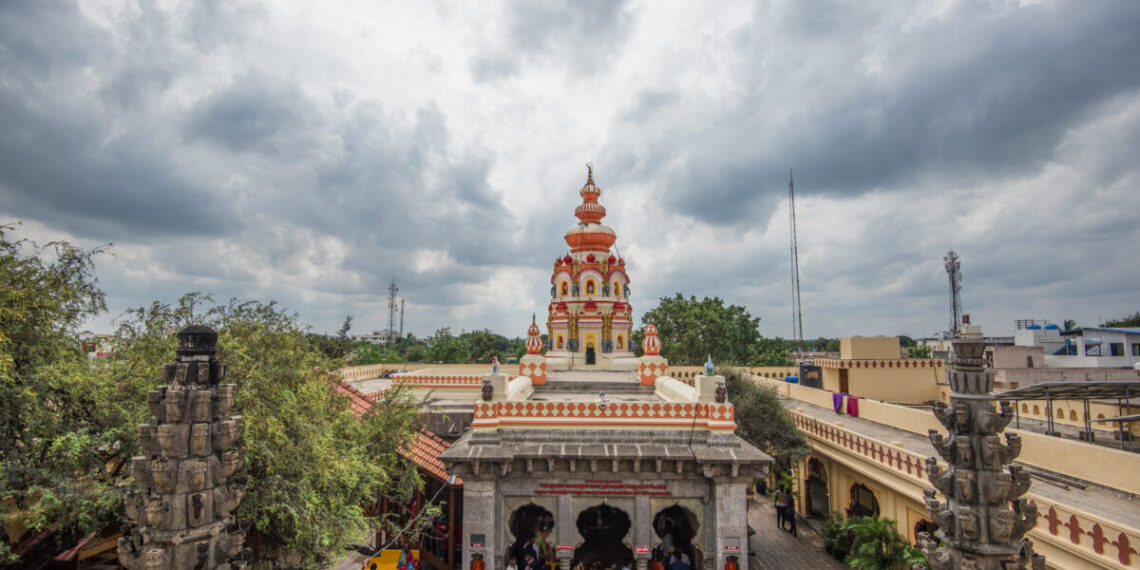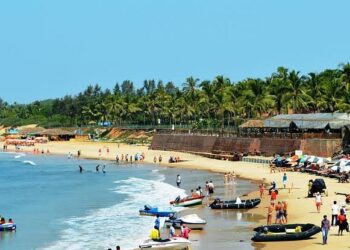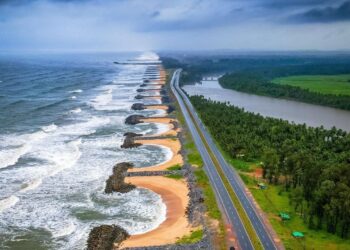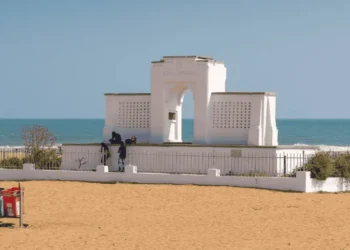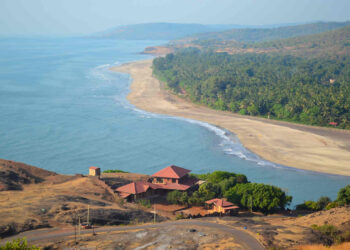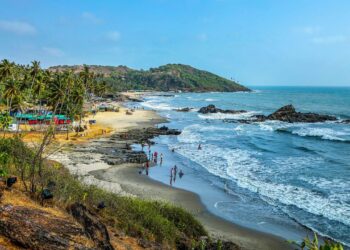Moreshwar Temple in Morgaon, Pune district, dedicated to Lord Ganesha as Mayureshwar, is a cherished shrine of faith. Set by the Karha River, about 65 km from Pune, its stone carvings, serene air, and sacred grounds draw devotees from across India. Spanning roughly 1 acre, it’s the first stop of the Ashtavinayak pilgrimage, a journey to eight Ganesha shrines, making it a cornerstone of devotion.
Historical Overview
The Moreshwar Temple is very old, reaching back to the 13th century, though some say worship began earlier. Morgaon, a quiet village 65 km from Pune, was a spiritual spot. Old texts and local talk credit Morya Gosavi, a Ganesha devotee, with building the temple before the 17th century. The Peshwas, Maratha rulers who revered Ganesha, added halls and walls in the 1700s, as stone writings show. The temple faced damage during invasions of Islamic invaders in the 1600s, but devotees protected the murti, hiding it in a nearby cave. It was rebuilt with help from local chieftains in the 1800s. In the 1900s, the Endowments Department spruced it up, keeping its old legacy.
Mythological Importance
The legend says that Devi Parvati, underwent twelve years of austerities meditating on the ‘OM’ mantra to please the Supreme God – Ganesha, at Lenyadri cave. On Bhadrapada Shuddha Chaturthi, she sculpted a clay murti of Ganesha and worshipped with devotion. Pleased by her penance, Lord Ganesha blessed her with the boon of being incarnated as her son. The clay murti then transformed into a real child and was named Gunesha.
Once, Gunesha broke an egg which was the progeny of Sage Kashyap and Vinita and a peacock emerged. The two duelled intensely. A distraught Vinita intervened, and the battle came to an end. Her peacock son chose to be Lord Ganesha’s vahana but had a unique condition: Lord Ganesha should be known by his name which was agreed by Ganesha. Thus was born the name, Mayureshwar or Moreshwar. Mounted on the peacock, Gunesha, as Mayuresvara, fought the demon Sindhu, who had unleashed terror on the three worlds and defeated him ultimately. At the end of this incarnation, Gunesha returned to his celestial abode, passing his peacock mount to his elder brother Skanda with whom the peacock mount is generally associated. According to a tradition, at the time of pralaya (the dissolution of the world), Ganesha will enter yoganidra here in Mayureshwor. Its sacredness is compared to the divine city of Kashi.
Temple Structure and Design
The Moreshwar Temple in Morgaon, Maharashtra, is crafted in the Hemadpanthi style, a 13th-century Maratha art, blending devotion with the village’s stark beauty. The temple looks like a small fort, with four corner towers and thick stone walls. The gopuram, restored in the 1800s, stands proud with stone carvings of Ganesha with his trunk curled, sages praying, and peacocks, framed by lotus and vine patterns. Painted in soft cream and ochre, it’s capped with a simple kalasa that catches the morning light. The sanctum houses a black-stone Ganesha idol, draped in gold cloth and fresh garlands, set beneath a white-painted vimana, its stepped roof symbolizing purity. The sanctum’s walls, smoothed by time, carry faint Peshwa-era etchings of Ganesha’s tales, glowing under oil lamps.
Small shrines for Shiva, Parvati, and Hanuman are scattered across the grounds, each carved from local basalt and sheltered by open stone canopies. Set by the Karha River, the temple is reached by a short stone path from Morgaon village, winding past neem and peepal trees. The courtyard, paved with uneven basalt, feels open yet sacred, fringed by old banyan trees that cast dappled shade. A small tank, fed by the river, is used for ritual dips, its edges carved with fish shapes, a Peshwa touch. The temple’s low walls, built from rough stone, have niches for Naga figures, believed to protect the grounds.
Carvings on pillars and walls tell Ganesha’s tales—his birth, his fight with Sindhu, and his love for modaks—etched with care to guide devotees. The temple’s build centers on worship, with every rock and carving pointing to Ganesha’s grace. The 1900s fixes added sturdy paths but kept the temple’s wild, holy spirit, making it a quiet spot for prayer and peace.
Rituals and Festivals
Ganesh Chaturthi in August or September is the grandest festival celebrated in the temple, marking Ganesha’s birth, with modak offerings and marches. Magh Shukla Chaturthi in January or February has homams (fire rituals) and idol worship. Sankashti Chaturthi, every month, sees lamp-lighting by the sanctum. Daily worship covers Suprabhata Seva (morning prayers), Archana (offerings), and Deeparadhana (lamp ritual). Services like Abhishekam and Ganapati Homam can be booked at the temple office. A prasad stall gives free laddoos for devotees. Modak Archana, giving sweets on Wednesdays, is for clear minds.
Information for Travelers
Hours and Entry: Open daily, 5:00 AM to 12:00 PM, then 3:00 PM to 9:00 PM. Entry is free, but rituals cost 50-300 rupees.
Clothing: Wear simple clothes covering shoulders and knees. Men doing rituals can wear dhotis and go bare-chested, as custom.
How to Get There:
Air: Pune International Airport, 80 km away, is nearest. Taxis take 2 hours, costing 2000-3000 rupees.
Train: Pune Railway Station, 65 km away, links to Mumbai (3 hours) and Hyderabad (12 hours). Autos to Morgaon cost 500-800 rupees.
Road: Morgaon is 65 km from Pune. Buses from Pune’s Swargate Bus Stand (2 hours) stop at Morgaon village, 1 km away. Autos cost 20-40 rupees.
Places to Stay: Morgaon has plain guesthouses like Bhakta Niwas (500-1000 rupees). Pune, 65 km away, has hotels like Hotel Shreyas (2000-4000 rupees). Stalls by the temple sell dosa, vada, and tea.
Best Time to Visit: October to March has good weather, 20-30°C. Weekdays are calm. Ganesh Chaturthi packs crowds, so book early.
Nearby Attractions: Siddhivinayak Temple, 100 km away in Siddhatek, is the next Ashtavinayak stop. Jejuri Khandoba Temple, 50 km away, is a lively hill shrine. Baramati, 30 km away, offers local markets.
